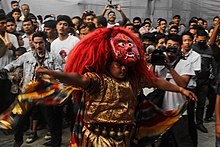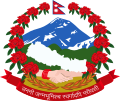Dance in Nepal
 | |
| Native name | नेपाली नाच |
|---|---|
Dance is a performing art form consisting of purposefully selected sequences of human movement. Dance (Nepal Bhasa:प्याखं/प्याखङ)(Nepali: नृत्य/ नाच) in Nepal comprises numerous styles of dances, including folk, ethnic, classical to modern dances. Lakhey is the dance of a demon in the carnival of God. Durbar Square, a historic plaza in Kathmandu, Nepal, facing ancient palaces and adorned by Hindu temples, is always full of eager crowds on the last day of Indra Jatra, the festival celebrating Indra, the Hindu king of heaven. In this divine stage, Lakhe the demon dances among gods and deities relentlessly and carelessly.
Origin

Legends state that dances in this country originated in the abode of Lord Shiva — the Himalayas, where he performed the tandava dance.[1] This indicates that dance traditions of Nepal are very ancient and unique. With altitudes and ethnicity, the dances of Nepal slightly change in style as well as in the costumes.
Ethnic and cultural dances
| This article is part of a series on the |
| Culture of Nepal |
|---|
 |
| Society |
| Arts and literature |
| Other |
| Symbols |
|
|
- Lakhey Pyakhan: performed during the Yenya festival in the month of September.[2]
- Bhairab Pyakhan: popular among Newar community in Kathmandu valley.[3]
- Chacha Pyakhan: is a Buddhist ritual dance with a history going back more than 1,000 years. It is performed by Newar Buddhist priests known as Bajracharya as part of their esoteric meditation practices and rituals. The dancers represent various deities like the Five Buddhas, Manjusri, Vajrayogini and Tara.
- Kumha Pyakhan: is a sacred dance of the Tuladhar and Kansakar caste groups of the Newars of Kathmandu. The dance is performed in temple and market squares during religious festivals.
- Gathu Pyakhan: is a sacred masked dance of the Newar people of the Kathmandu Valley, Nepal.
- Nava Durga Pyakhan: starts from mohani and ends in Bhagasti. It is famous around Newar community in Bhaktapur.
- Maruni Dance: traditional dance popular in Eastern Nepal, Sikkim, Assam, and Darjeeling, popular among Magar, Gurung, Kirati and It is believed to be originated from Magar Army during 14 the century on the behalf of sick King Balihang Rana Magar of Palpa, Pokhara Butwal.
- Deuda naach: popular in Karnali and far-west provinces.[4]
- Chyabrung Naach: the traditional dance of the Limbu people, living mainly in the Eastern part of Nepal.
- Dhan Nach: the traditional dance of the Limbu people, living mainly in the Eastern part of Nepal.
- Mayur Naach; Peacock Dance: performed by western magar specially Kham Magar, popular in the Mid-Western part of Nepal, especially Rolpa and Rukum.
- Sakela Naach: the traditional dance of the Khambu (Rai) community worshipping Lord Paruhang and Goddess Sumnima.
- Ghatu Nritya: performed among the Magar & Gurung community in western Nepal.
- Sorathi Nritya: performed among the Magar & Gurung community in western Nepal.[5]
- Hanuman Nritya: Popular in central Nepal
- Dishka Dance: performed at weddings, includes intricate footwork and arm movements.
- Hurra Dance: performed by Eastern Magar community
- Jhijhiya Dance: popular in the western and central Terai among Maithili community and some Bhojpuri communities of Madhesh province. Women put holey earthen pot with fire inside, on their head and dance in a group during Dashain.
- Jatjatin Dance: It is based on folk songs of Maithili and Tharu community which they perform from Shrawan Purnima to Bhadra Purnima. It is based on the love story of hero jat and heroine Jatin and their lives.
- Sakhiya dance: It is a traditional dance of Tharu community performed during the Dashain and Tihar festivals by the unmarried young girls and boys.
- Lathi Nach: It is also known as Tharu stick dance and is mainly performed during the Dashain festival.
- Gauna Dance: It belongs to the Mithila tradition and is popular in the Janakpur region and is performed on religious and festive occasion.
- Baalan Dance: It is performed by depicting the character of Lord Ram and Lord Krishna etc. especially by brahmin and Chhetri community.
- Syabru Dance: It is a folk dance of Sherpa and other Himalayan communities of Nepal.
Folk dances
- Tamang Selo dance
- Jhaure dance
- Lakhey nach dance
- Newari dance
- Manjushree dance
- Kaura dance
- Majhi nach dance
- Raute dance
- Chhokara dance
- Khyali dance
- Maruni dance
- Deuda dance
- Chaulo dance
- Dhan Nach dance
- Madikhole dance
- Phagu (dance)
- Sorathi
- Sakela (Chandi)
- Singaru
- Tarbare
- Bajrayogini dance
- Charitra dance
- Jat-jatin
- Charya dance
- Hanuman dance
Gallery
- People performing Deuda dance in Tudikhel, Kathmandu
- Maruni dancer
- Lakhey dance
- Tamang selo dance
- Lathi nach, folk dance of Tharu community
- Kelang, Limbu folk dance
- Kartik Nach, a 17th century dance form performed in Patan
See also
References
- ^ Shanmuganathan, Thilagavathi (2014). "A pragmatic analysis of Lord Shiva's dance". International Journal of the Sociology of Language. 2014 (229): 95–115. doi:10.1515/ijsl-2014-0019. ISSN 1613-3668.
- ^ "In pictures: Nepal festival season starts with goddess, dance". CNBC TV18. Retrieved 31 March 2020.
- ^ ""Bhairav Dance" performed in Kathmandu, Nepal". xinhuanet china. Archived from the original on September 26, 2019. Retrieved 31 March 2020.
- ^ "Nepal: Performing arts". UNESCO Asia Pacific cultural center. Retrieved 31 March 2020.
- ^ "Traditional Sorathi dance!". The Himalayan Times. Retrieved 31 March 2020.







